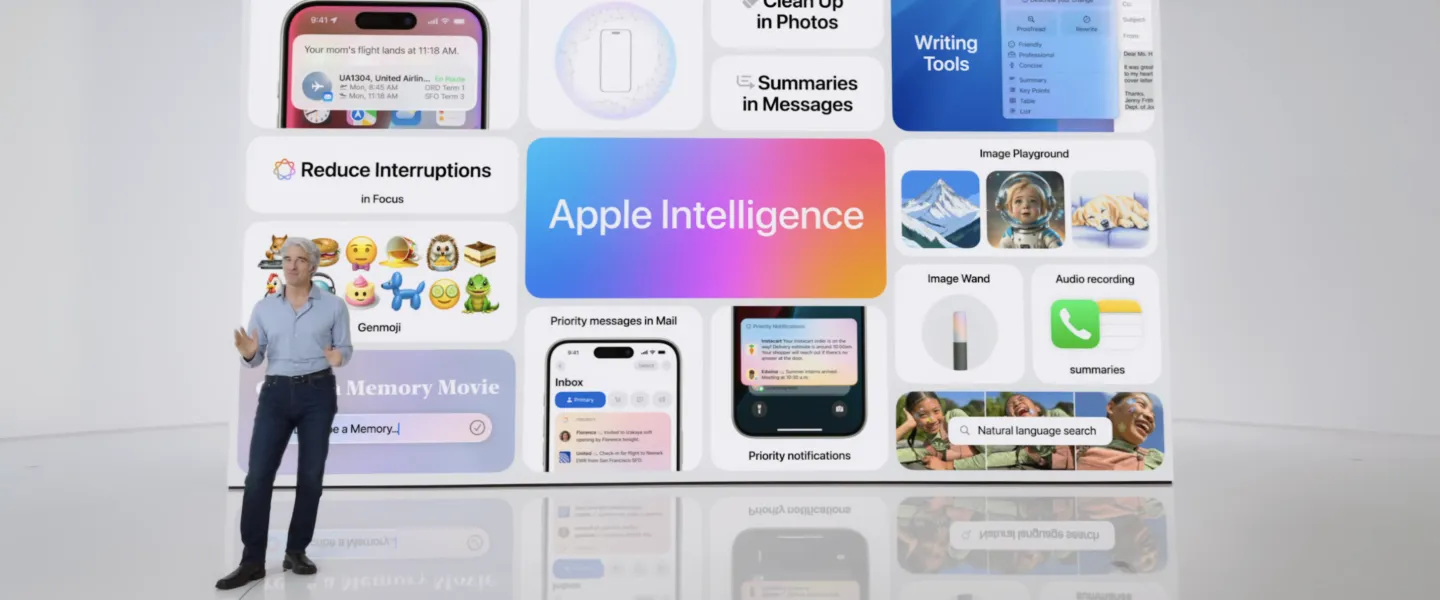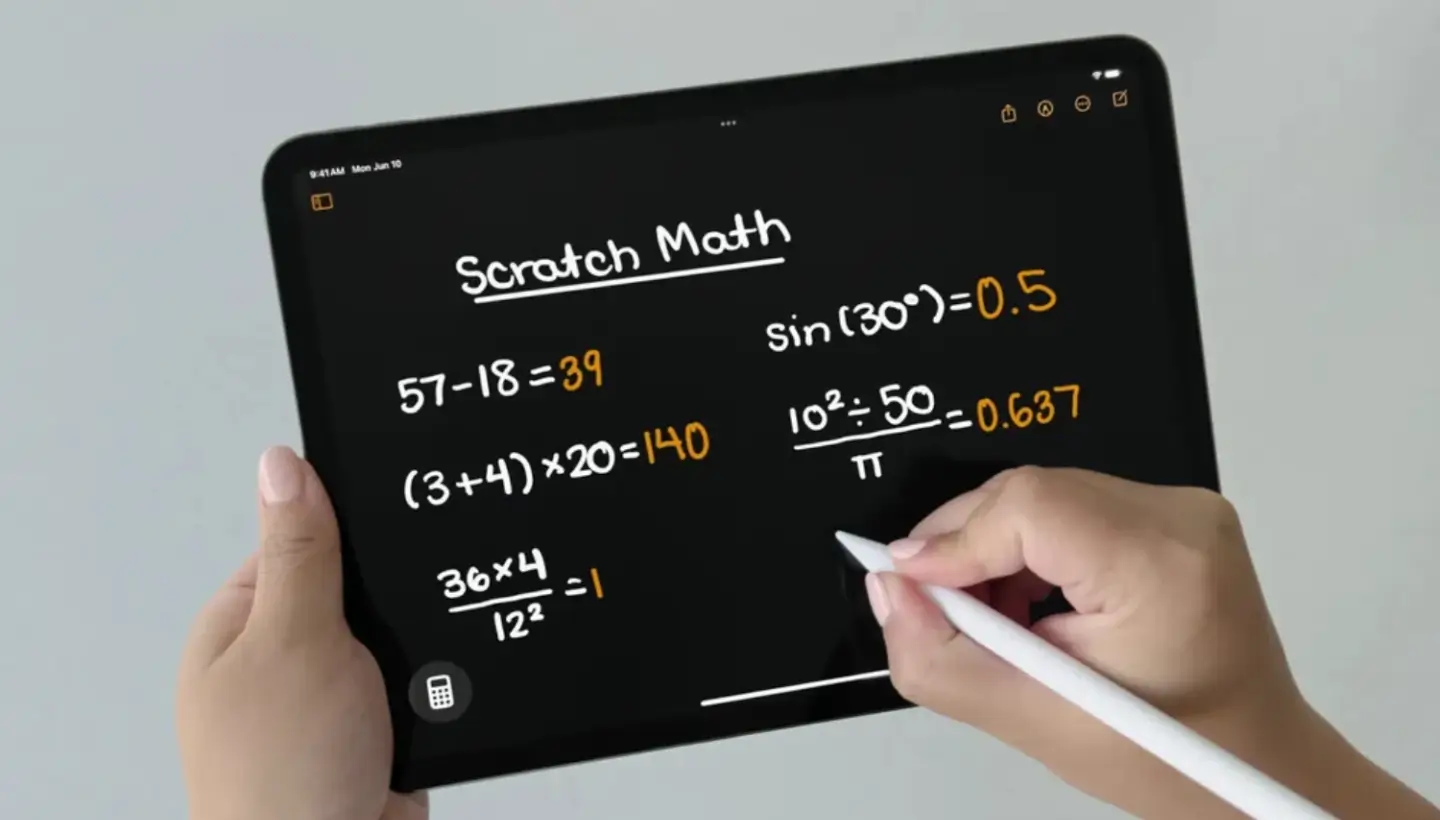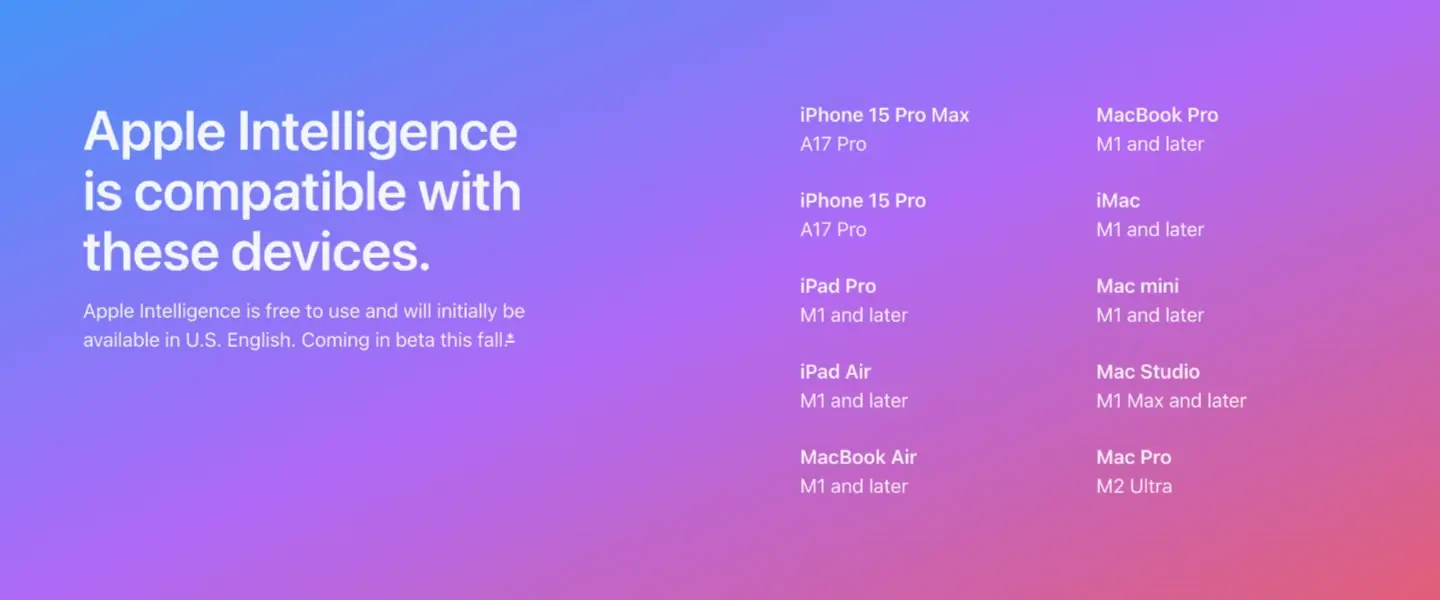Unpacking Apple's AI Strategy at WWDC 2024

Apple’s Worldwide Developer Conference 2024 (WWDC) kicked off this week, where, as expected, The Cupertino tech giant finally revealed their hand and demonstrated how AI will be coming to their devices and operating systems later this year.
With Microsoft and Google racing to out-AI each other, Apple have appeared to be behind the curve. Apple are rarely first to a category, but when they enter, it’s always time to pay attention. Their approach could shape how a billion consumers worldwide perceive and interact with artificial intelligence in their daily lives.
In this article, we’ll run through the key announcements from WWDC 2024, analyse Apple’s AI strategy, and explore the implications of their efforts to make AI more accessible and user-friendly.
Is Apple behind the curve?
Apple is perceived to be behind the curve when it comes to AI. Certainly, they are late to embrace LLMs. But, that isn’t the full picture.
The first Apple devices to feature a ‘neural engine’ - a dedicated hardware component specifically designed to handle machine learning tasks efficiently - was back in 2017 with the launch of the iPhone X and the A11 Bionic chip. This predates ChatGPT’s launch, and the consumer buzz and hype surrounding AI by a good five years.
More recently, Apple has switched their entire Mac line-up over to Apple Silicon. All M series processors feature a powerful neural engine, multiple GPUs and unified memory, resulting in a surprisingly capable processor for ML and AI tasks.
Apple are only late to the party if you view this moment as their entrance. But, they’ve been stocking the bar and getting the playlist ready for some time!
Apple Intelligence
Contrasting with the Google IO event last month, where Google proudly used AI to count that they had mentioned “AI” over 120 times during their keynote, I think I heard the term only once during the Apple keynote. Instead, Apple gave us a clever rebranding of AI as “Apple Intelligence”.

This is a classic Apple move. It allows them to claim ownership of a category which until now they have been conspicuously absent.
Arguably, it’s also a canny move. Whilst AI is making waves, with that comes some murky waters. By reframing the category, Apple can attempt to keep their trunks clean. Apple will be content to let Google rush head first into the AI deep end as long as it’s scoring those glue-on-pizza own goals, whilst Apple can dip its toes in and claim to be doing things differently.
New features of Apple Intelligence
Apple’s neural engine has been enabling subtle quality of life ML (Machine Learning) features such as predictive text or the various image recognition features in the Photos app for a while. Apple has never explicitly labelled these kinds of features as AI, but that is exactly what they are.
With Apple Intelligence, and the new OSes it will arrive with, Apple is significantly ramping up these kinds of ML-powered quality of life features all around the system - features that are designed to surface where you need them and when you need them.
Apple Intelligence brings plenty of new features - more than I can list - but here are a few that stand out:
- Writing tools - summarisation, proofreading, rewording, etc
- Image playground - generative image tools
- Genmoji - for those times when none of the standard 3,500 emoji icons perfectly express the required emotion
- Priority notifications, priority messages in Mail, email summaries and smart replies
- Photos - clean up tool, generate smart memories and collections, much improved semantic search
- Math Notes - genuinely impressive dynamically calculated results for mathematical formula and equations
- Smart script - use AI to smooth out your messy handwriting

Siri’s AI-powered upgrade
Siri, Apple’s much maligned digital assistant, is set for a long overdue and much needed kick up the virtual backside with some new LLM-powered abilities. Expect more natural exchanges of conversation, and deeper, more impressive abilities to instruct Siri to perform actions across different apps and systems. Siri is contextually aware of all our data - our contacts, calendar, photos and files - so there is a lot of potential for Siri to finally live up to the promise that it never quite delivered on.
And for those times when Siri isn’t able to help with your request, it has a buddy as backup. Where appropriate, Siri will ask you if you’d like your request to be handled by ChatGPT. You always explicitly opt in to this, and if you do GPT-4o will respond instead of Siri. This is free and available to all users without requiring an OpenAI account.
What’s the catch?

The big caveat that all of these Apple Intelligence features carry is that you will need a relatively new device to take advantage of them. When Apple Intelligence is released in the Autumn, it will only be available on the iPhone 15 Pro and above, or any Mac or iPad with an M-series processor.
The privacy tightrope
Apple’s reputation for user privacy is good and well deserved. They have stood out amongst the tech giants in defending users’ privacy and advocating for storing and processing data on device rather than in the cloud (and they take every opportunity to remind us when Google and Microsoft do the opposite).
For this reason, Apple finds itself in a tight spot. While small local ML models can impress for certain use cases, there will always remain a category of AI tasks that necessitate very large models hosted in data centres. Thus, if Apple is to compete, it must offload certain tasks to the cloud, and potentially undermine its good privacy reputation.
During the keynote, Apple emphasised privacy a lot. This is the approach they are taking:
- All user data is stored and processed locally, on device.
- The majority of AI workloads will also be handled on device using a 3B parameter LLM.
- Where necessary, Apple will offload more demanding AI workloads to what it calls “Private Cloud Compute” - Apple owned and controlled infrastructure where requests are encrypted and data never stored. Security researcher Mathew Green posted some good thoughts on this.
- Finally, for specific types of requests Apple will let users opt in to it being forwarded to OpenAI and GPT-4o. The agreement with OpenAI stipulates that they cannot to identify you through your requests or store your data, if you hold any weight in that. But the crucial thing is that you ultimately have the choice, on a per-request basis, whether or not the request goes out to OpenAI.
It’s reassuring that Apple emphasises privacy, but this is tricky ground for any tech company to navigate. Microsoft recently dug itself into a hole with it’s AI-powered Recall feature, demonstrating that sceptical consumers have not forgotten Snowden.
Conclusion
This feels like a solid, yet safe entrance to the AI battleground by Apple. Except for Math Notes (which was pleasingly delightful) and the promise of a more powerful and capable Siri, most of the quality of life AI features Apple is introducing fall into the “seen it before” category.
But what we can expect, in the way that Apple is uniquely adept at doing, is the tightest and neatest integrations, so these intelligence features surface exactly where and when a user needs them, in a way that, if you’ll excuse the cliché, “just works”.
Notably missing was any multi-modal vision and voice features, like Google demoed with Project Astra, and OpenAI is rolling out with GPT-4o. I suspect Apple are happy to err on the side of caution and deliver simple polished AI features, and let Google be the one telling its users to eat rocks!
Perhaps the most significant aspect of Apple Intelligence is its potential to bring AI capabilities to over a billion users around the world. Not just the tech nerds and AI enthusiasts, but everyday consumers. From grandparents to students, from professionals to hobbyists, Apple’s user base is as diverse as it is massive.
As Apple has done with past revolutionary technologies like the graphical user interface and multitouch screens, they now have the opportunity to make AI a ubiquitous part of our daily lives. If executed well, Apple Intelligence opens the doors to AI for billions of people, leading to truly global public understanding and acceptance of this technology.